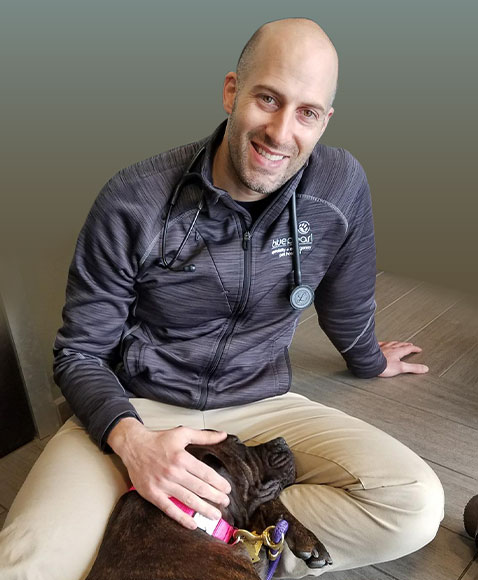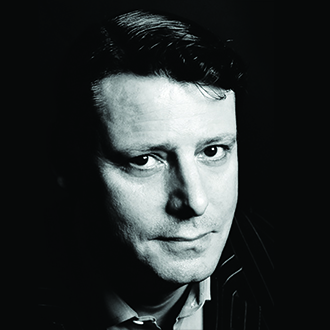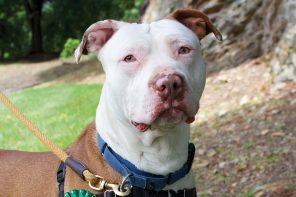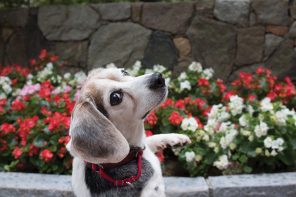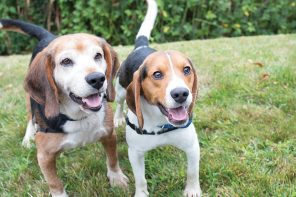With the Covid-triggered spike in pet ownership nationwide and the hugely popular “All Creatures Great and Small” having just aired on PBS, veterinarians may be the new superheroes. At least that’s how pet parents think of Thomas Monaco, D.V.M., a board-certified small-animal surgeon who specializes in orthopedic, oncologic and cardiothoracic procedures and pain management at Katonah Bedford Veterinary Center in Bedford Hills.
“Thank you so much, Dr. Monaco. You are a gift,” reads a random but hardly unique entry on his Facebook page. “The world needs more compassionate people like you.”
Recently, Monaco — whose family includes wife Francesca, and their two children, Leo, 7, and Ariana, 4, — took time from his busy schedule FaceTime with me about his work, his more unusual patients, his passion for triathlons and going to school in an island paradise:
Dr. Monaco, how did it all start? What was your first, how shall I put it, “animal awakening”?
“I was born in Manhattan but we moved to Rockland County when I was 3. There’s a videotape my parents have of me in second grade and they’re saying, ‘What do you want to be when you grow up?’ And I’m like, ‘I want to be a veterinarian.’ I mean, most people are born with a fondness for animals, but it’s always been something that’s really interested me.”
You had pets growing up?
“I had a bunch of pets growing up — rabbits, lizards, fish, cats. Never had a dog, though, which is funny.”
I guess it is. But at what point did it become concrete? When did you seriously start thinking of working with animals professionally, that this might become your career?
“It wasn’t until college. I went to an all-boys high school in New Jersey and then to Georgetown (University), where I played football. I was a premed major and I was going to go into the human side of things. My dad’s a family physician, my brother’s a pediatric cardiologist, my uncle’s a vet and another cousin’s a plastic surgeon….”
So, medicine was always on the cards.
“Yeah, well, precisely. We had so many medical people in the family that I just naturally went down that path. And then, my junior year of college, I took this comparative anatomy class, which compared animals to people. And my professor at Georgetown was actually a veterinarian and I started to think that I wanted to transition to the veterinary medicine route.”
An easy thing to do?
“My professor walked me through it. It’s a pretty tough admission process and I didn’t have any veterinary experience, but I took a year and worked with some hospitals and with my uncle on Long Island, who does a lot of exotics and birds, so I got some really good experience. And then got into the veterinary school at St. George’s University in Grenada, which is where my dad actually went to medical school in the 1980s. Mind you, a lot changed on the island between the ’80s and the time I went there.”
Ah yes, the U.S. invasion of Grenada in 1983.
“And the (Grenada invasion-inspired) movie ‘Heartbreak Ridge.’ But, oh my God, going to school in the Caribbean was amazing — living on a paradise island for three years.”
Frankly, I’m surprised you got any work done.
(Laughs) “Well you’re there to do your thing — the medicine aspect of it — so you have to get on with it.”
Still, I bet you’re missing all that Caribbean sunshine right now.
“I went back for the first time seven years after I graduated. I spoke at their White Coat ceremony. You know, I became a scuba instructor when I was down there. I logged around 500 dives in three years. So, yes, I do miss that aspect of it.”
I’m going to come on to leisure activities in just a moment, but I want to ask about how you eventually landed at the Katonah-Bedford Veterinary Center.
“So, after our son was born, when I was working in Princeton, I found a job at Katonah and (my wife and I) moved back up there. But things are always changing with the specialty side and new hospitals and opportunities are always coming up. So next I went to Paramus for three years, but there were managerial changes and (pauses) … and then I came back to Katonah.”
And you’re happy to be back in Westchester?
“Very much so. And it’s great to have joined with all the techs I have here. They’re amazing.”
What are you particularly known for at the center?
“I’d say surgery and oncology, plus we also have a good core of emergency doctors. We deal with orthopedics, cranial cruciate ligament tears (knee injuries) that dogs get, fracture repairs. But surgical oncology is probably the majority of the caseload and that’s generally what I enjoy most. Trying to cure these dogs from cancers and tumors.”
How have things advanced in the last five or 10 years?
“Well, we tend to follow human medicine. People are doing heart valve replacements in dogs now and we’re also able to do regenerative joint medicine, like stem cell, and something called platelet rich plasma, all of which we adapted from human medicine. We also do thoracoscopy (minimally invasive chest surgery) and interventional radiology. So yes, it’s amazing how far we’ve come in being able to treat things which only recently would have likely resulted in euthanasia.”
That’s tremendous. Now, I know there’s no such thing as a typical vet’s day, but at the risk of sounding banal, what is your typical day like?
“Well, we see appointments in the morning and then we always have surgery in the afternoon, Monday to Thursday, up to five surgeries a day. It can be pretty fast-paced out there.”
And do you see exotic pets?
“I personally don’t, but I have a friend who’s a vet to local zoos and I’ve done quite a few zoo animal surgeries with him, which has been amazing.”
Tell me more.
“One of the coolest collaborative efforts I was involved with was at a zoo in Westchester, which had a baby orangutan with an inguinal [protruding] hernia. You know, a primate is kind of like a baby, so I hooked up with my brother at Columbia and he hooked me up with a pediatric surgeon, and we did the surgery together. And then, two years ago I got the chance to do a fracture repair on a female lion, at a zoo in New Jersey, which was also a huge collaborative effort. There’s not a lot of fracture repairs in lions. It was awesome.”
You must certainly have trusted the anesthesiologist.
“Right, it wouldn’t be like having a little cat wake up on you. Actually, they darted her first and then five of us got her on to a stretcher and brought her down to the hospital in a van. We had to volunteer as to who wanted to go in the back with her.”
Now, apart from cutting-edge surgeries and riding around in vans with lions, I know you are also a triathlete.
“It started in Grenada. One of my classmates had done an Ironman and he’s like, ‘You should do some triathlons with me.’ I did my first triathlon on the island of Nevis, which snowballed into doing the New York City Triathlon, along with some others. And then my brother and I thought, ‘Let’s do an Ironman’ And one of the most well-knowned ones is probably Lake Placid, a pretty challenging course. And I liked it so much, I did another one the following year, in Mont Tremblant in Quebec.”
They say a busy vet has time for everything. And then?
“And then my son was born, so I did a few shorter ones and then kind of put it on hold. Now it’s just tennis with dads from town.”
For more, visit vcahospitals.com/katonah-bedford.

